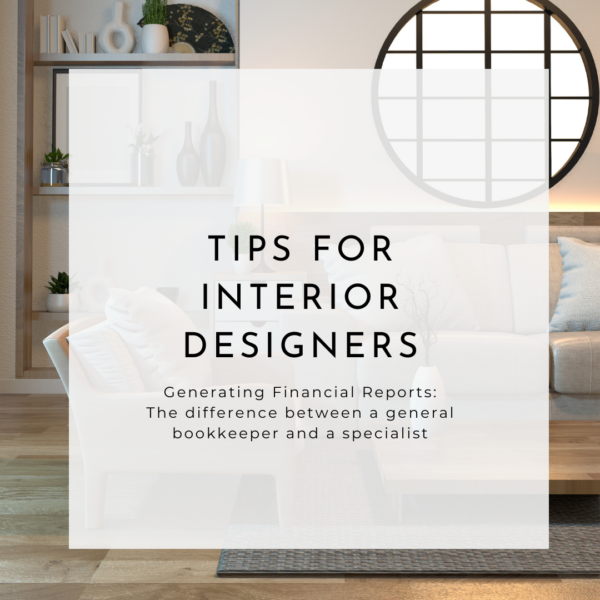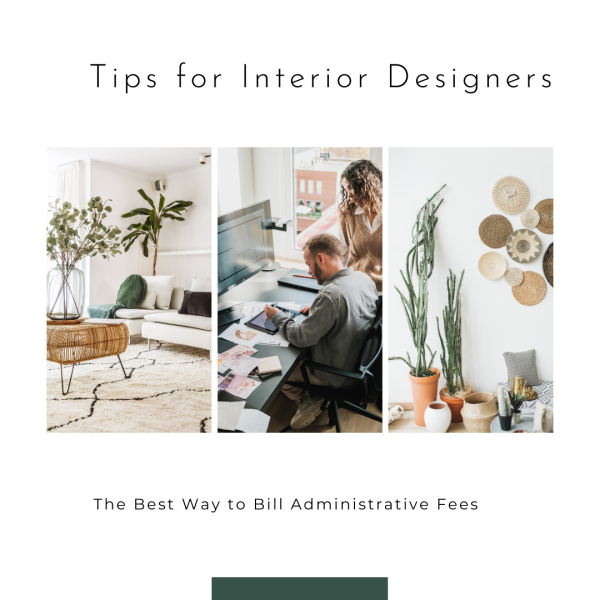Table of Contents
Our very own Marissa Jones explains how designers can practice better bookkeeping. You can find the full webinar below, but here is a quick guide if you are short on time.
Marissa started working with her first interior designer in 2013 and discovered almost immediately that interior designers encounter a unique struggle: to find an accounting professional who understood their industry. As a result, Marissa quickly learned the industry and has used her knowledge and expertise to help designers all over the country. One thing that she continuously stresses to designers is that successful accounting is all about the workflow process. She views this as the most important aspect of accounting for interior designers.
Getting Started
- It is so important to work with a bookkeeper who knows the interior design industry.
- Get your systems set up before you begin
- Set up a test account!
- Get paid before you order or at least signed approval.
It is no secret that finding the right bookkeeper can be a struggle for interior designers. Even the most experienced, highly-recommended bookkeepers can fall short if they are not familiar with interior design practices. It is imperative that you find the right bookkeeper who knows your industry and has experience with working specifically with interior designers. There will be a huge learning curve if they are not familiar with Ivy/Houzz Pro + Quickbooks integration. Working with experienced interior-design bookkeepers will save you stress, time, and minimize your company’s vulnerability to potential audits!
Before you begin, make sure your systems are properly set up. If you are using Ivy/Houzz Pro before connecting to Quickbooks Online, hire an accounting professional experienced in your software to set up your mapping and categories that match accurately to your chart of accounts in Quickbooks. If the foundation is not set up correctly you could fall into issues with the accuracy of your financial statements. We have a proven formula for mapping that is best for interior designers for analyzing your numbers and for sales tax.
You should always set-up a test client and project in Ivy and run tests first! Run tests to check that the integration is functioning properly. Follow recommended steps for your industry and double-check that your mapping is translating to Quickbooks seamlessly. This makes your job and your bookkeeper’s job so much easier. With accurate data inputted, you can even auto-generate reports from Quickbooks to see where you stand financially.
What’s the point of the process?
Now, what’s the point of the better bookkeeping process? To make sure all invoices are sealed, accurate, completed in a timely manner, and to make sure everything is paid. This ensures that purchase orders, payments, project tracking can be properly documented. When this process is done correctly, you will be able to have constant access to see the accurate liability of your company at any given time. Pulling accurate tracking reports, seeing what is paid and what needs to be paid. For example, you receive a $100,000 check from a client, but you are required to pay out $80,000. Your account balance will show as the full $100,000, however, only $20,000 of that is your actual cash balance that you can spend.
TIP: Use the Ivy/Houzz Pro Integration for customized financial reporting.
The Steps for the Best Workflow Process
Before you begin, ensure that your system is properly set up. You should always set-up a test account first! Follow your steps, and input accurate info to Quickbooks. This makes your job and your bookkeeper’s job so much easier. With accurate data inputted, you can even auto-generate reports from Quickbooks to see where you stand financially.
Here are the steps:
- Designers create items and proposals which their clients approve or send payment.
- Once client payment has been received, payment should be applied to a proposal.
- Immediately after client payment is applied, the designer should create an invoice.
- Once the payment is received and the invoice is created, the designer should create purchase orders directly from the paid invoices.
- The purchase orders created in Ivy should be open for reference during the ordering process and matched to vendor invoice/receipt backup for accuracy while ordering.
- Purchase orders should match the vendor invoice EXACTLY. If the purchase order is less than the vendor originally quoted and you need to bill the client more, a new item should be created and added to a new proposal. Although possible, NEVER alter invoices once created. If everything is done in sequence, and correctly, all financial reports should be accurate in real-time.
- Immediately after an item is ordered, the designer should post vendor payment to purchase the order in Ivy.
If everything is done correctly and in sequence, all financial reports should be accurate in real-time.
Make sure you have authorization from clients to use Quickbooks Online. One of the most important things for better bookkeeping is to make sure you are getting paid before you order. All invoices and purchase orders need to be closed and completed before moving on. You also need to know what is yours to spend in your bank account and what is the client’s. This is account balance versus cash balance, which is important to know at any given time so that you aren’t accidentally spending more than you should be. Many designers think they are able to track this on their own, but things get tricky when you are working with multiple clients on multiple projects at one time! This is another reason why it is so important to have accurate financial data at all times and make sure you are effectively tracking and documenting everything.
Integration
Note that there are things that might need closer attention to detail because not everything will automatically transfer to Quickbooks. However, if you have followed our recommendation and hired a bookkeeper who is familiar with the industry, they will likely know what they are doing. This is just another reason to stay in communication with your bookkeeper, to help you get a better idea of the process and of your numbers at the same time.
Accrual Based Accounting
Most reports in interior design are accrual reports – any time you create an invoice, it is counting it as though your payment has been received, whether or not it actually has been paid. If you always follow the steps, your cash-based reports and accrual reports are going to be almost exactly the same. This is great when working with sales and income tax. You want this information to be as accurate and consistent as possible.
Know Your Sales Tax Laws
What’s taxable and not taxable? When in doubt, give them a call! Your state’s tax office will guide you on how best to calculate taxes based on their specific tax laws. Do not assume every state is the same! When you aren’t fully aware of all the nuances of state tax laws, you might get yourself in situations that are far from ideal. For instance, if you don’t immediately collect sales tax on something that’s due, and you try to go back & bill a client on sales tax that should have been collected a year ago, it is highly unlikely that the client will pay that tax – and highly likely that you will be liable to pay it yourself.
Never pay tax to a vendor. If this is unavoidable, there are ways you can track this in Ivy. It is probably a good idea to keep a separate log or spreadsheet on vendor-paid taxes. You don’t want to pay tax to a vendor and then have to pay it back to the state because it was missed.
Keep it Simple, Stay in Touch with your Bookkeeper
We recommend weekly calls with your bookkeeper. Work with them to generate the reports you need to keep your finances in check. Make sure you understand the reports! There are so many important aspects of your business that your bookkeeper can help you understand with correct reports. As your business grows, you want to be able to keep track of your numbers and know exactly where you’re at any given time. Communication and understanding are key to success!
About Ivy
Ivy is the fastest-growing community and business management tool for interior designers. If you’re an interior designer still looking for an intuitive tool to run your firm, check out ivy.co and schedule a personal demo with the Ivy Team here
About Logistis for Designers
Logistis is a cloud-based accounting firm specializing in interior design. Our team can help carry you through the entire accounting process, from start to finish. We can set up the financial portion of your office, integrate your systems, run your payroll, prepare your taxes and offer assistance with financial planning along the way.




